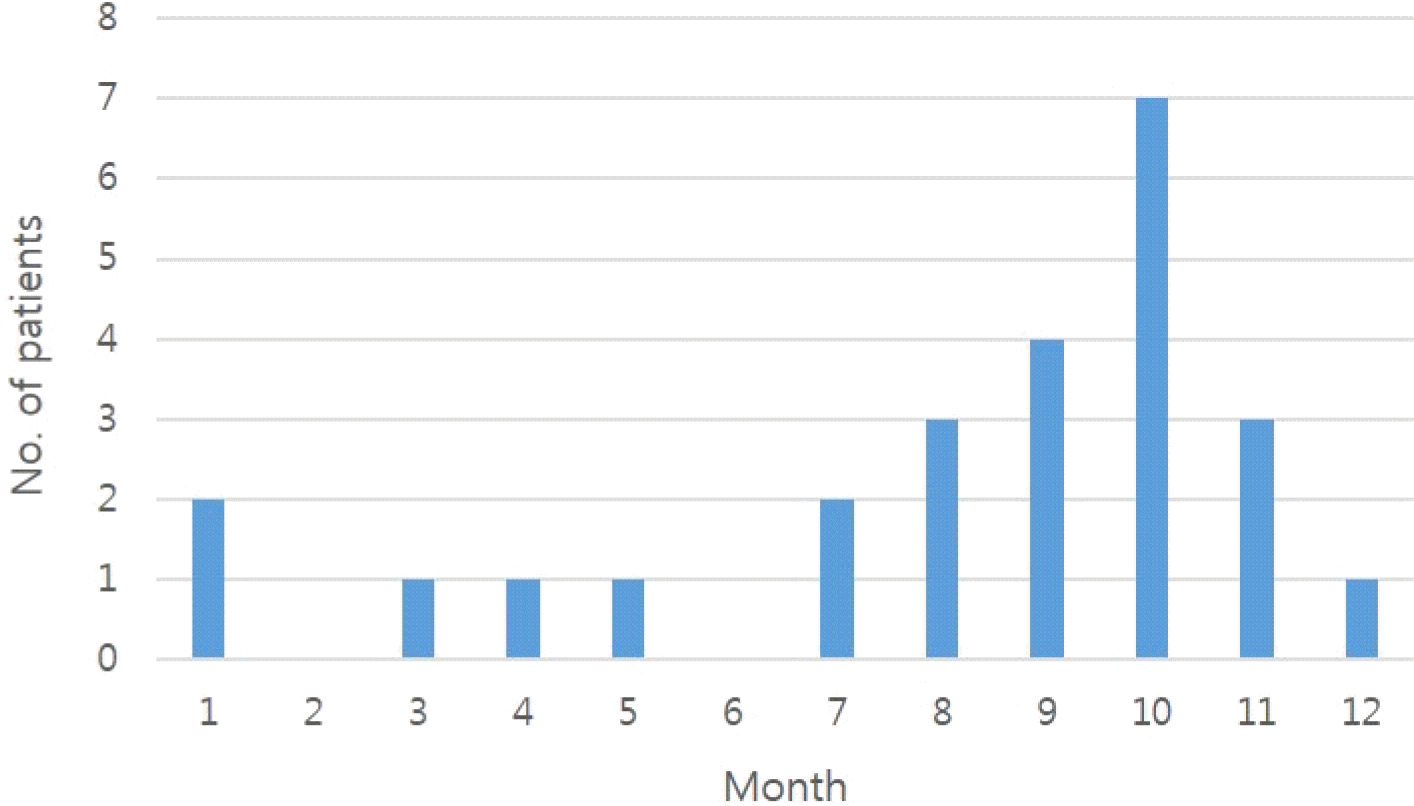Abstract
Objectives
Systemic antibiotic therapy with semisynthetic penicillinase-resistant penicillin or vancomycin and clindamycin are recommended for the treatment of staphylococcal scalded skin syndrome (SSSS). This study assessed the rate of antibiotic resistance of Staphylococcus aureus isolated from the anterior nares or skin of children diagnosed with SSSS.
Methods
A retrospective review of the medical records of 25 patients with SSSS between July 2010 and October 2014 was conducted. The clinical characteristics of patients were collected and the antibiotic susceptibility of S. aureus were analyzed using automated systems.
Results
The median age of the patients was 22 months (range: 2-95). Ninety-two percent of patients were less than 5 years of age. Nasal swab samples of all patients and skin swab samples of 17 patients were cultured to isolate S. aureus. Twenty-one (84%) of 25 patients were colonized with methicillin-resistant S. aureus (MRSA). The results of swab samples of the other four patients were no growth or isolation of bacteria other than S. aureus. Among 20 strains isolated from the anterior nares, 1 strain (5%) was methicillin-susceptible S. aureus. All 15 strains isolated from the skin were MRSA. All 21 strains isolated from anterior nares or skin were found to be resistant to clindamycin upon evaluation using automated systems.
REFERENCES
1.Lillibridge CB., Melish ME., Glasgow LA. Site of action of exfoliative toxin in the staphylococcal scalded-skin syndrome. Pediatrics. 1972. 50:728–38.

2.Dancer SJ., Noble WC. Nasal, axillary, and perineal carriage of Staphylococcus aureus among women: identification of strains producing epidermolytic toxin. J Clin Pathol. 1991. 44:681–4.

3.Adesiyun AA., Lenz W., Schaal KP. Exfoliative toxin production by Staphylococcus aureus strains isolated from animals and human beings in Nigeria. Microbiologica. 1991. 14:357–62.
4.Heo SY., Song YJ., Kim SJ., Park SY., Kang DC., Ma SH. A clinical review of community acquired methicillin resistant staphylococcal scalded skin syndrome. Korean J Pediatr Infect Dis. 2007. 14:83–90.

5.Lee J., Sung JY., Kim YM., Oh CE., Kim HB., Choi EH, et al. Molecular characterization of methicillin-resistant Staphylococcus aureus obtained from the anterior nares of healthy Korean children attending daycare centers. Int J Infect Dis. 2011. 15:e558–63.

6.Ko KS., Lee JY., Baek JY., Peck KR., Rhee JY., Kwon KT, et al. Characterization of Staphylococcus aureus nasal carriage from children attending an outpatient clinic in Seoul, Korea. Microb Drug Resist. 2008. 14:37–44.
7.Park AY., Yeon EK., Lee HK., Shin MY. A clinical review of staphylococcal scalded skin syndrome for the last 10 years. Soonchunhyang Med Sci. 2012. 18:32–7.

8.Jeon H., Ma SH., Jo HJ., Woo MS., An H., Park H, et al. Long-term persistence of sequence type 89 methicillin-resistant Staphylococcus aureus isolated from cases of staphylococcal scalded skin syndrome in a Korean community. J Med Microbiol. 2016. 65:1542–4.

9.Juern A. Staphylococcal scalded skin syndrome. Kliegman RM, Stanton BF, St Geme JW, Schor NF, editors. editors.Nelson textbook of pediatrics. 20th ed.Philadelphia: Elsevier;2015. p. 3206–7.

11.Ladhani S. Understanding the mechanism of action of the exfoliative toxins of Staphylococcus aureus. FEMS Immunol Med Microbiol. 2003. 39:181–9.
12.Ladhani S., Joannou CL., Lochrie DP., Evans RW., Poston SM. Clinical, microbial, and biochemical aspects of the exfoliative toxins causing staphylococcal scalded-skin syndrome. Clin Microbiol Rev. 1999. 12:224–42.

13.Ericson JE., Popoola VO., Smith PB., Benjamin DK., Fowler VG., Benjamin DK Jr, et al. Burden of invasive Staphylococcus aureus infections in hospitalized infants. JAMA Pediatr. 2015. 169:1105–11.
14.Shibl AM. Role of Staphylococcus aureus exfoliatin toxin in staphylococcal infections in mice. Chemotherapy. 1981. 27:224–7.
Table 1.
Clinical characteristics of 25 children diagnosed with staphylococcal scalded skin syndrome
Table 2.
Results of bacterial cultures using swab specimens from the anterior nares and skin
| Nasal swab (N = 25) | Skin swab (N = 17) | |
|---|---|---|
| Isolation of S. aureus | 20 (80) | 15 (88) |
| MRSA | 19 (76) | 15 (88) |
| MSSA | 1 (4) | 0 (0) |
| No growth or isolation of bacteria other than S. aureus | 5 (20) | 2 (12) |
Table 3.
Antimicrobial susceptibility of Staphylococcus aureus isolates by colonization sites
| Antibiotics |
n (%) |
|
|---|---|---|
| Anterior nares (N = 20) | Skin (N = 15) | |
| Penicillin | 1 (5) | 0 (0) |
| Oxacillin | 1 (5) | 0 (0) |
| Clindamycin | 0 (0)* | 0 (0)† |
| Erythromycin | 0 (0) | 1 (6.7) |
| Gentamicin | 2 (10) | 0 (0) |
| Ciprofloxacin | 20 (100) | 15 (100) |
| Rifampin | 20 (100) | 15 (100) |
| Vancomycin | 20 (100) | 15 (100) |
| Trimethoprim/sulfamethoxazole | 20 (100) | 15 (100) |




 PDF
PDF ePub
ePub Citation
Citation Print
Print



 XML Download
XML Download